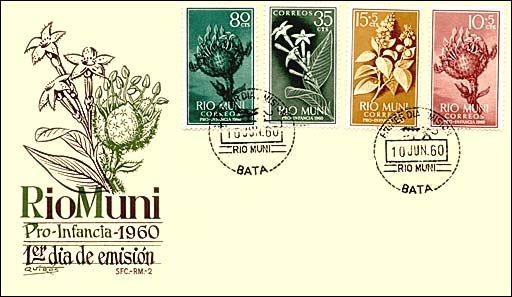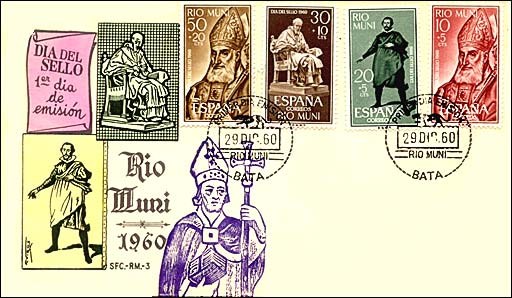|
RIO MUNI
HISTORY AND STAMPS
Río Muni, located just north of the equator, is made up of
lowland along the coast, which gradually rises in the interior to a maximum
height of c.3,600 ft (1,100 m).
Río Muni includes three major rivers—the Campo, which forms
part of the northern boundary; the Benito, located in the center; and Río
Muni, which forms part of the southern boundary.

The main ethnic group in Río Muni, where most of the
population lives, is the Fang. The population of Bioko is primarily made of
the Bubi (the oldest of the modern-day inhabitants), descendants of slaves
from W Africa liberated by the British in the 19th century, and Nigerians and
Fangs who migrated there in the 20th cent. Spanish is the official language.
In 1778, Portugal ceded the islands, and also the commercial rights to a
part of the African coast that included present-day Río Muni, to the
Spanish. Hoping to export Africans as slaves to their American possessions,
the Spanish sent settlers to the islands, but they died of yellow fever, and
by 1781 the region was abandoned by the Europeans.
From 1827 to 1843 the British leased bases at Malabo (then called Port
Clarence) and San Carlos from Spain for use by their antislavery patrols,
and some freed slaves were settled on Bioko (then called Fernando Po).
In 1844 the Spanish reacquired Bioko and began to occupy it. Under the
Spanish, economic development was largely confined to Bioko, although some
measures were taken in Río Muni beginning in the 1940s. By 1960, about 6,000
Europeans (mostly Spanish) were living in the colony, and they controlled
the production of cocoa and timber. In 1959 the colony was reorganized into
two overseas provinces of Spain, each under a governor.

In 1963, Spain granted the country (renamed Equatorial
Guinea) a limited amount of autonomy, and on Oct. 12, 1968, it received
complete independence.
Source:
http://www.bartleby.com/65/eq/EquatrGu.html
The stamps and the FDC
shown above were issued between 1952 and 1958. They show drummers, hunters,
a women with a dove, arms, and a preaching missionary and
a crucifix (Scott B 49, 75th anniversary of Catholic Missions in Spanish
Guinea).
For more information about above stamps and FDC's
please point to them with the mouse index. Credits: many thanks to Tracy Barber
(USA) for scans of FDC's.
|